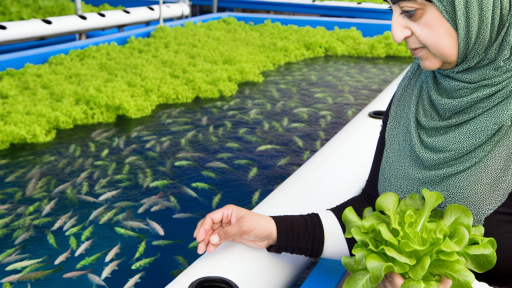Understanding Organic Farming Principles
Definition of Organic Farming
Organic farming emphasizes sustainable practices and environmental stewardship.
This method avoids synthetic fertilizers and pesticides.
Instead, it relies on natural inputs and processes.
Core Tenets of Organic Agriculture
Organic farming is guided by several key principles.
Firstly, it maintains ecological balance and biodiversity.
Secondly, it promotes soil health and fertility.
Moreover, it supports animal welfare and humane treatment.
Finally, organic farming encourages community engagement and education.
Benefits of Organic Practices
Organic farming offers numerous benefits to farmers and consumers alike.
To begin with, it leads to healthier food options.
These foods often have higher nutritional value.
Additionally, organic farming practices improve soil health.
This results in better crop yields over time.
Furthermore, organic farms contribute to environmental protection.
Challenges in Organic Farming
Starting an organic farm can present challenges.
Transform Your Agribusiness
Unlock your farm's potential with expert advice tailored to your needs. Get actionable steps that drive real results.
Get StartedFor instance, transitioning from conventional to organic methods takes time.
Also, organic crops may sometimes yield less than conventional ones initially.
Additionally, certification can be complex and time-consuming.
Certification and Standards
To be recognized as organic, farms must meet specific standards.
These standards vary by country and certification body.
Typically, they include guidelines on inputs and farming practices.
Farmers must maintain records and undergo inspections.
Community and Support
Joining organic farming networks can enhance success.
These networks provide knowledge and resources.
They also foster collaboration among organic farmers.
Additionally, educational programs can help newcomers learn valuable skills.
Researching Suitable Crops for Your Region
Understanding Local Climate
Your region’s climate plays a critical role in crop selection.
Select crops that thrive in your area’s temperature and precipitation patterns.
To make informed choices, evaluate seasonal variations in your climate.
Utilizing climate data can help you determine the best planting times.
Furthermore, consider local frost dates to avoid crop loss.
SoiConditions and Quality
Soihealth directly impacts crop growth and yield.
Conduct a soil test to assess pH, nutrients, and texture.
Understand which crops are best suited to your soil type.
Improve soil health by incorporating organic matter and crop rotation.
This practice enhances soil fertility and structure over time.
Market Demand Analysis
Research local market trends to identify high-demand crops.
Visit farmers’ markets to observe customer preferences firsthand.
Engage with local agricultural cooperatives for insights on popular choices.
Showcase Your Farming Business
Publish your professional farming services profile on our blog for a one-time fee of $200 and reach a dedicated audience of farmers and agribusiness owners.
Publish Your ProfileThis information guides you in selecting profitable crops.
Consider starting with niche products to differentiate your farm.
Regional Pest and Disease Challenges
Each region faces unique pest and disease pressures.
Educate yourself on common pests affecting various crops in your area.
Utilizing resistant crop varieties can minimize these challenges.
Additionally, implement integrated pest management strategies to protect plants.
This approach promotes sustainable farming practices while lowering risks.
Consulting Local Agricultural Resources
Your local agricultural extension office is an invaluable resource.
They provide guidance on best practices for sustainable farming.
Additionally, attend workshops and seminars to expand your knowledge.
Networking with other farmers can also offer practical insights.
Finally, explore online forums and social media groups related to farming.
Choosing the Right Land and Soil Preparation Techniques
Selecting Suitable Land
Choosing the right land is crucial for success.
Consider location, climate, and accessibility.
Look for areas with a history of successful farming.
Investigate soil types and their fertility levels.
Assess water availability for irrigation purposes.
Understanding Soil Characteristics
Conduct soil tests to determine quality.
Analyze pH levels, nutrient content, and texture.
Healthy soil contains a balance of organic matter.
Consider crop rotation to maintain soil health.
Use native plants to improve soil quality.
Preparing the Land for Planting
Clear the land of debris and weeds.
Till the soil to aerate it effectively.
Incorporate organic matter like compost and manure.
This practice enhances soil fertility naturally.
Furthermore, consider using cover crops to enrich the soil.
Implementing Soil Conservation Techniques
Soi conservation prevents erosion and degradation.
Utilize contour farming to retain moisture.
Employ no-till farming methods to reduce soil disturbance.
Plant buffer strips to protect against runoff.
Regularly monitor soil health for long-term success.
Explore Further: Early Detection Methods For Crop Disease Forecasting
Obtaining Organic Certifications and Permits
Understanding Organic Certifications
Organic certifications assure consumers about the quality of products.
They usually require adherence to specific agricultural practices.
Additionally, these certifications promote sustainable farming methods.
Various organizations provide these certifications worldwide.
Familiarize yourself with the requirements in your country.
Identifying Certification Bodies
Start by researching the relevant certification bodies.
In the United States, the USDA offers organic certifications.
Showcase Your Farming Business
Publish your professional farming services profile on our blog for a one-time fee of $200 and reach a dedicated audience of farmers and agribusiness owners.
Publish Your ProfileOther countries have their own local certifying agencies.
It is crucial to choose a body recognized in your market.
Contact these agencies to understand their processes and fees.
Preparing for Certification
Before applying, assess your farming practices thoroughly.
Ensure that you follow organic practices consistently.
Keep records of all inputs, outputs, and practices used.
This documentation will be vital during inspections.
Develop a plan to transition to organic if you haven’t done so.
Applying for Certification
Once ready, complete the application for certification.
This application may require detailed information about your farm.
Include specifics about your soil, crops, and pest management strategies.
Be honest and transparent in your application to avoid issues.
After submitting, prepare for an on-site inspection from the certifying body.
Maintaining Certification
After successfully obtaining certification, you must maintain it.
Regularly update your records to reflect any changes.
Follow organic practices consistently to avoid penalties.
Expect annual inspections to confirm ongoing compliance.
React promptly to any feedback from inspectors to improve processes.
Obtaining Necessary Permits
In addition to organic certifications, you may need various permits.
Check local regulations regarding farming operations.
Permits could relate to land use, water management, or pesticide application.
Contact local agricultural offices for specific requirements.
Ensure all permits are acquired before starting farming operations.
Staying Informed on Regulations
Stay updated on changes in organic regulations.
Regulations can shift based on new research or political changes.
Attend workshops or join farming associations to network.
Network with other organic farmers to share insights and strategies.
Regularly review websites of certifying bodies for updates.
See Related Content: Starting Your Own Hydroponic Garden
Creating a Business Plan for Your Organic Farm
Understanding the Importance of a Business Plan
A business plan outlines your farming goals and strategies.
It provides direction and clarity for your farming operations.
Moreover, it helps attract investors and secure financing.
Ultimately, a solid plan can guide you through challenges.
Defining Your Mission and Vision
Your mission statement should reflect your farming values.
It should explain why you want to start an organic farm.
Similarly, your vision statement outlines your future goals.
Create a clear picture of where you want to be in five years.
Conducting Market Research
Research is essential for understanding your target market.
Identify who your customers will be.
Look for local demand for organic produce in your area.
Showcase Your Farming Business
Publish your professional farming services profile on our blog for a one-time fee of $200 and reach a dedicated audience of farmers and agribusiness owners.
Publish Your ProfileAnalyze your competition to find your unique selling points.
Defining Your Product Offerings
Decide what crops you want to grow organically.
Consider popular options like vegetables, fruits, or herbs.
Ensure your choices align with market demand.
Additionally, consider value-added products like jams or sauces.
Developing a Production Plan
Your production plan should outline your farming methods.
Detail your soil management and crop rotation strategies.
Include pest management practices that adhere to organic standards.
Specify your planting and harvesting schedules.
Creating a Financial Plan
A financial plan forecasts your startup and operational costs.
Estimate potential revenues from crop sales.
Determine your break-even point and profitability timeframe.
Consider funding sources such as loans or grants.
Establishing a Marketing Strategy
Your marketing strategy promotes your organic farm.
Identify effective channels like farmers’ markets and social media.
Build customer relationships through community engagement.
Develop a branding strategy that highlights your values.
Setting Measurement and Evaluation Metrics
Define key performance indicators for your farm’s success.
Track your progress against the goals outlined in your plan.
Regularly evaluate your strategies and adjust as necessary.
Stay flexible to adapt to changing market conditions.
Discover More: Utilizing Technology In Pest And Disease Forecasting

Developing Sustainable Pest and Weed Management Strategies
Understanding Integrated Pest Management
Integrated Pest Management (IPM) combines various strategies to manage pests efficiently.
This method reduces reliance on chemical pesticides.
It focuses on understanding pest life cycles.
Additionally, IPM uses natural predators for pest control.
Farmers can promote beneficial insects in their fields.
Encouraging Biodiversity
Biodiversity boosts ecosystem health and resilience.
Planting diverse crops attracts different pollinators and pests.
Crop rotation helps disrupt pest and disease cycles.
Mixing crops can confuse pests, reducing infestation rates.
Utilizing Organic Control Methods
Organic pest control methods are effective and environmentally friendly.
Farmers can apply neem oil as a natural pesticide.
Insecticidal soaps can tackle soft-bodied insects such as aphids.
Moreover, physical barriers prevent pests from reaching crops.
Fostering Healthy Soil
Soil health plays a crucial role in pest management.
Healthy soil supports strong plant growth.
Use compost to improve soil structure and nutrient content.
Cover crops can suppress weeds and prevent erosion.
Practicing no-till farming helps maintain soil health.
Showcase Your Farming Business
Publish your professional farming services profile on our blog for a one-time fee of $200 and reach a dedicated audience of farmers and agribusiness owners.
Publish Your ProfileAdopting Manual and Mechanical Techniques
Hand-pulling weeds is an effective method in small areas.
Mulching suppresses weeds by blocking sunlight.
Mechanical tools can also help manage larger weed populations.
Monitoring and Record Keeping
Regular monitoring helps track pest populations and crop health.
Farmers should maintain detailed records of pest activity.
This information aids in making informed management decisions.
Additionally, keeping records helps assess the effectiveness of management strategies.
Collaborating With Experts
Consulting with agricultural extension services can provide valuable insights.
Local universities often conduct research on regional pest management.
Networking with other organic farmers can share best practices.
Learn More: Enhancing Soil Fertility with Cover Crops
Implementing Crop Rotation and Diversity for Soil Health
Understanding Crop Rotation
Crop rotation is the practice of growing different crops in the same area across growing seasons.
This method reduces soil nutrient depletion and pest buildup.
By alternating crops, farmers can improve soil structure and fertility.
Additionally, it helps in the control of soil erosion.
Benefits of Crop Rotation
Crop rotation enhances biodiversity in agricultural ecosystems.
It also breaks cycles of pests and diseases.
This practice results in healthier crops and increased yields.
Moreover, it can improve the economic viability of farming operations.
Diversity in Planting
Incorporating diversity in planting can have significant advantages.
Growing a variety of crops creates a balanced ecosystem.
Diverse root systems improve soil aeration and structure.
Additionally, different crops can help prevent diseases.
Best Practices for Implementing Crop Rotation
Start by assessing your soil’s nutrient needs and pH level.
Plan your crop rotation schedule considering crop families.
Include legumes to fix nitrogen in the soil.
Heed the advice of local agricultural extensions for tailored guidelines.
Examples of Crop Rotations
- Nightshades followed by legumes.
- Root vegetables followed by brassicas.
- Grains followed by cover crops.
Each rotation cycle builds a stronger and healthier farming system.
In essence, a well-planned crop rotation strategy nourishes the soil and boosts productivity.
Marketing Your Organic Produce: Building a Customer Base
Understanding Your Target Market
Identify the demographics of customers interested in organic produce.
Research local consumer preferences and trends in organic products.
Engage with your community to learn about their needs.
Creating a Unique Selling Proposition
Determine what sets your farm apart from competitors.
Offer unique varieties or specialty products to attract customers.
Highlight your sustainable farming practices in your marketing.
Utilizing Online Platforms
Establish a website to showcase your farm and products.
Use social media to connect with potential customers.
Share regular updates about your farm’s activities and harvests.
Participating in Local Farmers’ Markets
Find farmers’ markets in your area where you can sell your produce.
Engage with customers face-to-face to build relationships.
Showcase Your Farming Business
Publish your professional farming services profile on our blog for a one-time fee of $200 and reach a dedicated audience of farmers and agribusiness owners.
Publish Your ProfileOffer samples to encourage purchases at these markets.
Building Partnerships with Local Businesses
Collaborate with restaurants and grocery stores to supply fresh produce.
Develop relationships with health food stores to reach health-conscious consumers.
Offer promotional discounts for first-time customers or bulk orders.
Implementing a Community Supported Agriculture Program
Encourage locals to subscribe to your farm’s produce delivery.
Provide regular updates and newsletters to keep members informed.
Involve customers in your farming practices through farm tours.
Gathering Customer Feedback
Solicit feedback to improve your products and services.
Use surveys to gather insights on customer satisfaction.
Make adjustments based on customer preferences and suggestions.




